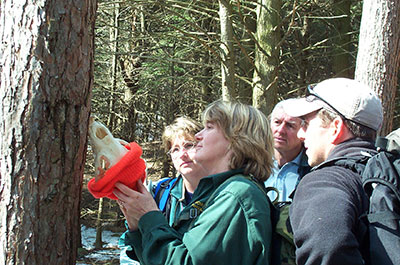“Community engagement” in the context of the PLACE Program is the collaborative process by which PLACE staff work with diverse local populations and institutions to become more deeply involved in their natural and cultural surroundings. Landscape Analysis,  explored in detail in other sections of this website, is the specific framework for an engagement process that looks at where the town has been and the forces that have made it what it is today. Using a combination of school-focused place-based education techniques, adult-centered community presentations and field trips, and a dynamic community visioning process, the PLACE Program’s community engagement model is an effective tool for encouraging people to explore and understand their own environs more fully, and a powerful catalyst for individual and community stewardship action. By engaging many different people from one community in this exciting process, the PLACE Program promotes improved community vitality and a stronger investment in home.
explored in detail in other sections of this website, is the specific framework for an engagement process that looks at where the town has been and the forces that have made it what it is today. Using a combination of school-focused place-based education techniques, adult-centered community presentations and field trips, and a dynamic community visioning process, the PLACE Program’s community engagement model is an effective tool for encouraging people to explore and understand their own environs more fully, and a powerful catalyst for individual and community stewardship action. By engaging many different people from one community in this exciting process, the PLACE Program promotes improved community vitality and a stronger investment in home.
PLACE does not advocate for a specific future landscape condition; rather our place-based education efforts with students, teachers, and adult community members seek to interpret the present town landscape from an integrative perspective that weaves together geological, historical, and ecological themes.  With an emphasis on helping local people to analyze and interpret their own landscape, we attempt to tell the story of how the landscape has unfolded through time, with a focus on the inter-relationships between natural and cultural history.
With an emphasis on helping local people to analyze and interpret their own landscape, we attempt to tell the story of how the landscape has unfolded through time, with a focus on the inter-relationships between natural and cultural history.
Such an integrated and inclusive educational effort fosters both a sense of community and a sense of place – a potent combination that leads to a more informed and creative town planning process. By providing forums for exploring the cultural and ecological landscape values held in common by the community, the stage is set for engaging the community in visioning efforts that transcend the divisive nature of many land-use debates and build toward a visioning process that promote consensus and informed decisions. It builds a bridge that connects a place’s past and present to a sustainable future.
While increasing community engagement in focus towns has been an objective of the PLACE Program since its inception in 1997, program staff members have placed even greater emphasis on this theme in recent years. To this end, we have developed a flexible set of activities that maximize opportunities for community members to initiate or take part in shared explorations of their town’s natural and cultural heritage. As a community becomes more involved with PLACE, the core components of the program, as displayed in the diagram on the About Us page, are tailored into a sequence of ever-increasing levels of community engagement. The corresponding colors on the diagram below show how these core components help community involvement to increase, to the point where the community can sustain the goals of the PLACE Program far into the future. Each of these core program elements may be explored in greater depth by clicking on the items in the left-hand menu.
This timeline of events reflects the sequence of increasing involvement in a community.
 explored in detail in other sections of this website, is the specific framework for an engagement process that looks at where the town has been and the forces that have made it what it is today. Using a combination of school-focused place-based education techniques, adult-centered community presentations and field trips, and a dynamic community visioning process, the PLACE Program’s community engagement model is an effective tool for encouraging people to explore and understand their own environs more fully, and a powerful catalyst for individual and community stewardship action. By engaging many different people from one community in this exciting process, the PLACE Program promotes improved community vitality and a stronger investment in home.
explored in detail in other sections of this website, is the specific framework for an engagement process that looks at where the town has been and the forces that have made it what it is today. Using a combination of school-focused place-based education techniques, adult-centered community presentations and field trips, and a dynamic community visioning process, the PLACE Program’s community engagement model is an effective tool for encouraging people to explore and understand their own environs more fully, and a powerful catalyst for individual and community stewardship action. By engaging many different people from one community in this exciting process, the PLACE Program promotes improved community vitality and a stronger investment in home. With an emphasis on helping local people to analyze and interpret their own landscape, we attempt to tell the story of how the landscape has unfolded through time, with a focus on the inter-relationships between natural and cultural history.
With an emphasis on helping local people to analyze and interpret their own landscape, we attempt to tell the story of how the landscape has unfolded through time, with a focus on the inter-relationships between natural and cultural history.